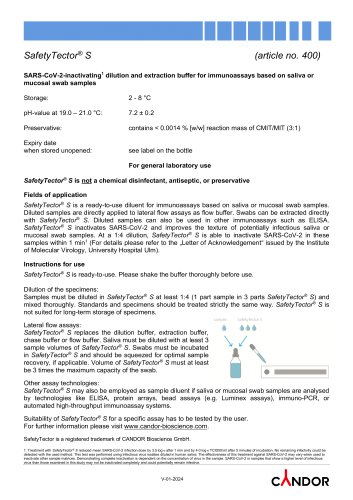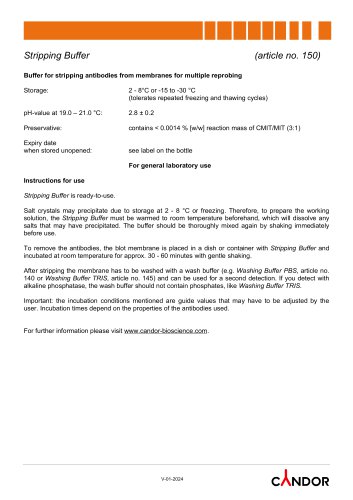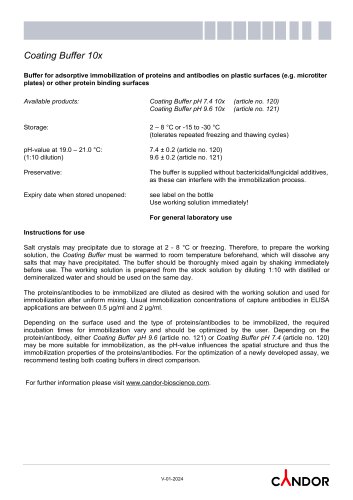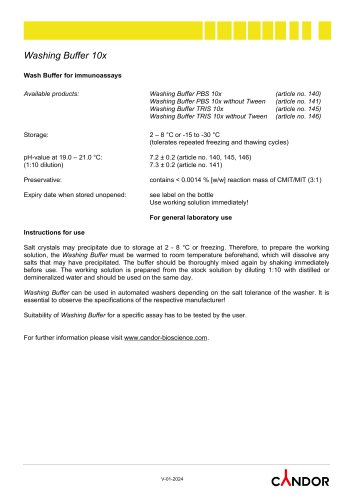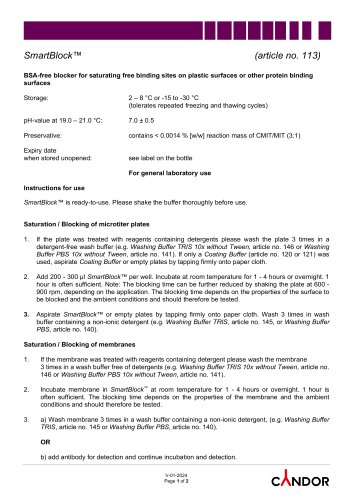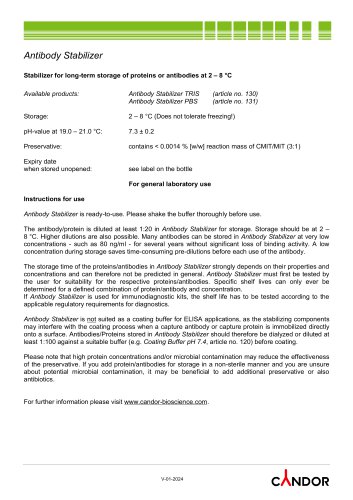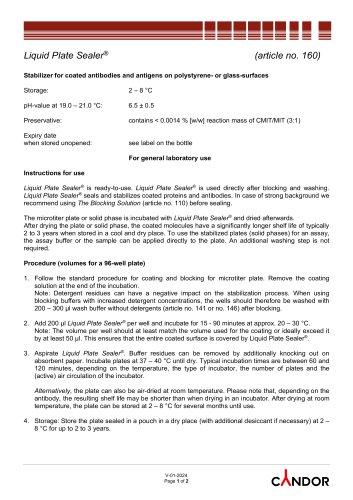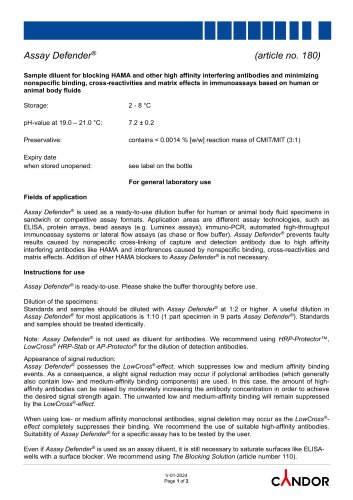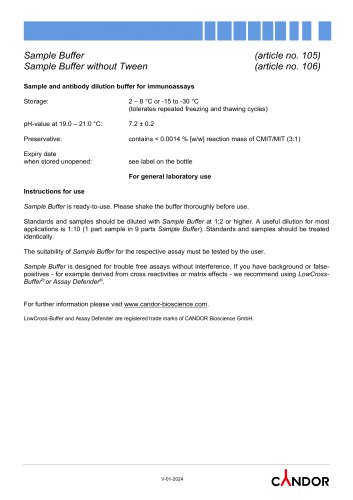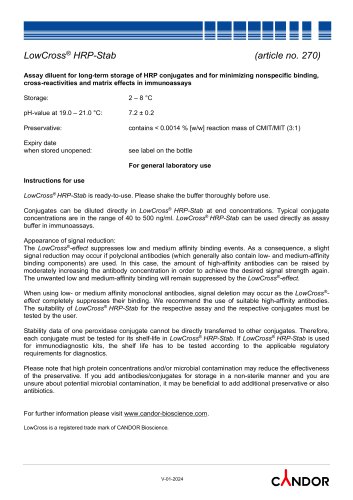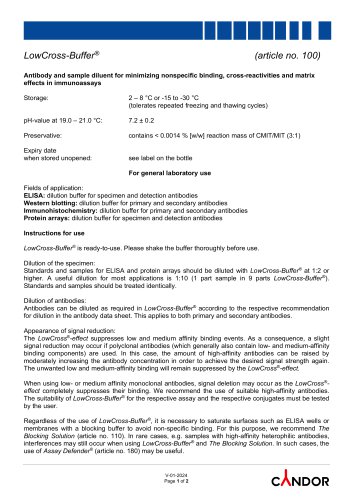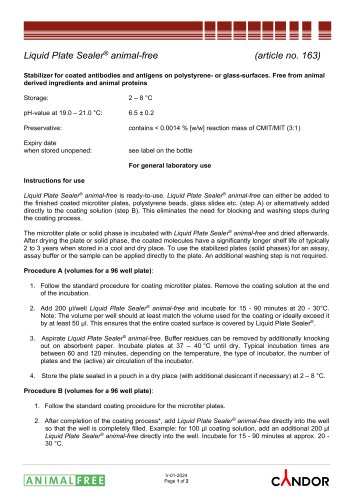 Website:
CANDOR Bioscience
Website:
CANDOR Bioscience
Catalog excerpts

Animal-free and protein-free blocker for saturating free binding sites on plastic surfaces, optimized for reducing background in serological assays. Storage: 2 – 8 °C or -15 to -30 °C (tolerates repeated freezing and thawing cycles) contains < 0.0014 % [w/w] reaction mass of CMIT/MIT (3:1) Expiry date when stored unopened: see label on the bottle For general laboratory use Instructions for use PlateBlock™ is ready-to-use. Please shake the buffer thoroughly before use. PlateBlock™ is a blocker for surfaces and must not be used for dilution of samples or assay antibodies. Saturation / Blocking of microtiter plates 1. After immobilization in Coating Buffer (article no. 120 or 121) plates are emptied by aspiration or by firmly tapping the plate onto paper cloth. For optimal results, plates must not come in contact with detergent prior to blocking. Add 200 - 300 µl PlateBlock™ to each well. Incubate at room temperature for 2 hours for optimal saturation in most applications. Incubation time can be minimized by shaking the plate at 600 900 rpm. The duration of blocking depends on the properties of the surface to be blocked and the ambient conditions and should therefore be tested individually. Overnight incubation is possible. Aspirate PlateBlock™ or empty plates by firmly tapping onto paper cloth. For optimal blocking results in serological assays, wells should not be washed between blocking and stabilization with Liquid Plate Sealer® (article no. 160) or application of samples. For other assay formats, washing 3 times in wash buffer containing a non-ionic detergent, e.g. Washing Buffer TRIS (article no. 145) or Washing Buffer PBS (article no. 140), may prove beneficial. Suitability of PlateBlock™ for a specific assay must be tested by the user. For very small capture antigens in antigen-down-assays, slight reductions in signal intensity due to masking of coated antigens by PlateBlock™ may be observed. However, PlateBlock™ still increases the signal-to-noise-ratio in these assays due to a disproportionate reduction in background signals according to experience. In case satisfying results cannot be obtained with PlateBlock™ , e.g. if your specific surface cannot be blocked sufficiently to reduce background signals to an acceptable level, we strongly recommend using The Blocking Solution (article no. 110) and/or exchange of the assay diluent to LowCross-Buffer® (article no. 100). For further information please visit www.candor-bioscience.com. LowCross-Buffer is a registered trade mark of CANDOR B
Open the catalog to page 1All CANDOR Bioscience catalogs and technical brochures
-
SafetyTector® S
1 Pages
-
Stripping Buffer
1 Pages
-
Coating Buffer 10x
1 Pages
-
Washing Buffer 10x
1 Pages
-
BSA-Block
1 Pages
-
SmartBlock™
2 Pages
-
ReadyTector
4 Pages
-
BUFFERS AND SOLUTIONS
20 Pages
-
The ELISA Experts
8 Pages
-
AP-Protector®
1 Pages
-
HRP-Protector™
1 Pages
-
Antibody Stabilizer
1 Pages
-
Liquid Plate Sealer®
2 Pages
-
LowCross® HRP-Stab
1 Pages
-
Assay Defender®
2 Pages
-
Sample Buffer
1 Pages
-
Blocker selection
3 Pages
-
LowCross® HRP-Stab
1 Pages
-
LowCross-Buffer®
2 Pages


